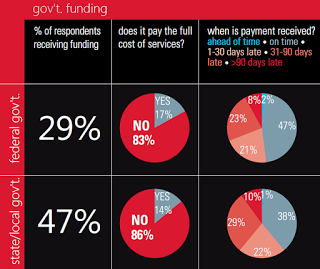Tags
Research Friday: Government contracting in the new normal

Welcome to Research Friday! As part of a continuing series,we invite a nonprofit scholar, student, or professional to highlight current research reports or studies and discuss how they can inform and improve day-to-day nonprofit practice.
Nonprofit Finance Fund’s (NFF) 2013 State of the Sector survey explored a variety of financial and management challenges facing organizations across the country. The core story, as told by nearly 6,000 respondents, is of a fragile balancing act between rising community need and shrinking or stagnant resources for social programs. Particularly in the last several years, in the wake of the financial crisis, organizations have struggled with a variety of challenges related to government support.
In the United States, we rely on government to provide key economic supports. We expect the federal, state, and local governments to play a role in educating our children, helping communities rebuild after natural disasters, and improving our collective quality of life. To deliver on this mandate, services like public education are administered by the government, while many other complementary programs - such as job training and placement - are outsourced to nonprofits. According to a 2010 Urban Institute study, nonprofit organizations (with records of income data) reported that nearly one-third of their revenue sources came from the government.
But there's a catch: when demand for critical services goes up and people are least able to pay, government spending for social services typically goes down. Available government resources are tied to the same macro-economic trends that cause an increase in service demand. Says one NFF survey respondent: "Our state contract rates have been cut to a point that it is almost impossible to break even and deliver services with a reasonable level of quality while also complying with contract requirements."

In the midst of these ever-shifting resource dynamics are the consistent, structural challenges
embedded in government contracting. According to NFF’s survey, 83% of nonprofits with federal contracts noted that the contracts did not cover the full costs of delivering services; 86% reported failure to cover costs at the state/local level. Anecdotally, NFF’s clients often report payment of about 70 cents on the dollar for the actual value of the services they provide. So to cover the true cost of working with the government, nonprofits must supplement their contracts through private donations and other fundraising efforts.
Do you know the difference between accrual and cash basis accounting?
On top of the “full cost funding” disparity, the government also struggles to pay their contractors in a timely manner. At both the federal and state level, over half of NFF’s respondents reported payment delays, with over 30% experiencing delays of more than three months. Says one survey respondent: “We cannot get our funds paid without 6 months delay from the state. Then you have to use a lobbyist to even get the state to pay out on its debts. We have to demonstrate to the state that we have exhausted all reserves, completely maxed out on line of credit, and show that we cannot make the next payroll before [it] will even pay us the money owed to us.” These payment delays have resulted in the expansion of a secondary support sector composed of nonprofit investors and CDFIs like NFF, private foundations, fundraising consultants, and many others. In effect, this system has created an entire industry dedicated to alleviating financial trauma for front-line nonprofit service providers.
While organizations juggle the management of government contracts and search for supplemental income to bridge the revenue gap, they must also navigate the complexities of the government contracting system. Many of NFF’s clients report that managing government contracts is a “program” in and of itself. To support their critical community work, social service nonprofits often manage a byzantine patchwork of competitive contracts, each with different payment schedules, reporting processes, and expectations for data collection. As with any business, it’s a delicate balancing act to achieve a reliable business model. Nonprofits, however, are different from their for-profit peers because they are also critiqued for the enterprise-related costs and staff time that this work requires.
As much as we all want to keep overhead costs low and direct our funding to support “direct program costs,” the data from NFF’s survey should ground these ideals in reality. The costs associated with managing government contracts are real: when government reimbursements arrive late, staff time is required to manage the resulting cash flow challenge. Fees and interest paid to draw on a line of credit are simply not expenses that many government agencies are willing to reimburse—even when the agency is the cause of the cash flow disruption. Nonprofits have weathered difficult contracting rules for decades, but these regulations become untenable combined with environmental circumstances, like an economic downturn. Particularly now, as nonprofits report significantly less funding available to support their work in meeting the nation’s basic shelter, nutrition, and educational needs.
These are not easy problems to solve, and many state and local governments continue to work hard to address them. While the difficulties are many, so are the solutions. In our next post, we’ll be discussing some of the adaptations and innovations around government funding that nonprofits and their supporters are employing to address some these challenges.
Anjali Deshmukh is a director and Angela Francis is a manager at Nonprofit Finance Fund (NFF). A 501(c)(3) nonprofit, NFF pushes for improvement in how money is given and used in the sector. Since 1980, we have worked to connect money to mission effectively, so that nonprofits can keep doing what they do so well. NFF provides financing, consulting, and advocacy services to nonprofits and funders nationwide.
